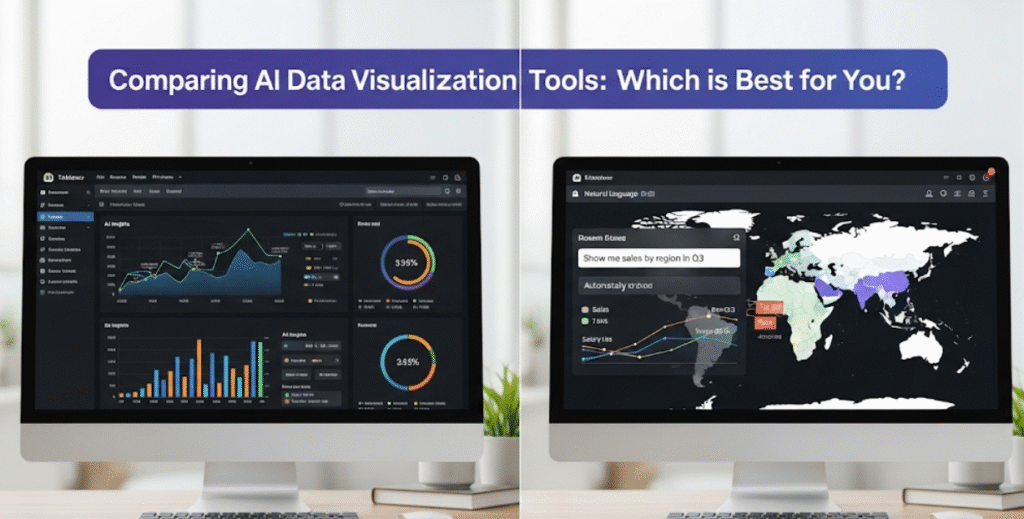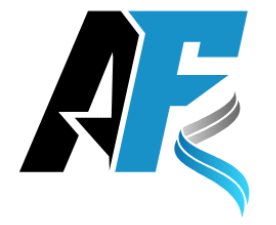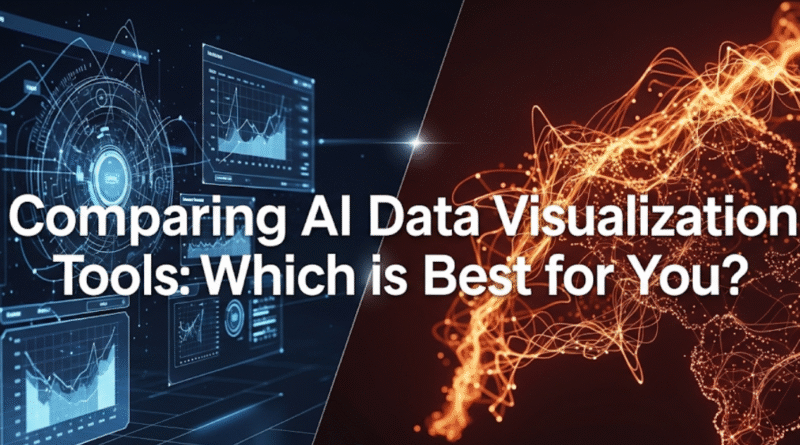Comparing AI Data Visualization Tools: Which is Best for You?
Data can tell a tale, but it must be told the right way. As Artificial Intelligence changes the way we analyze and visualize data, using the right AI-enabled visualization tool may be the difference between plotting confusing charts and cracking crystal clear insights.
Use Cases: Business owners tracking sales, students working on a research project, data analysts presenting findings.
In this guide, we will review the best AI data visualization platforms to help you figure out which tool is most suitable based on functionalities and budget.
Why Is AI Data Visualization Better?
Other tools to create charts require you still manually select chart types, set colors, format layout etc. This is where AI-powered visualization tools completely change the game.
- Automated Chart Type Recommendations for your data streamlined
- Spotting patterns and trends that you might overlook yourself
- Make designs that look good even if you aren’t a graphic designer
- Creating insights and explanations with the support of the visual elements
- Visualizations should reflect the audience and purpose
And with their smart features, they do the hard work which can take hours when you already have a full-time job, plus produce much more accurate and fun results compared to manual methods.
You may like: AI-Powered Business Intelligence: The Future of Decision Making
The Top 7 AI Data Visualization Products in Use by 2025
1. Tableau with AI Features
Ideal for: Mid- to large-sized enterprises with very complex data requirements
“Ask Data” and some automated analytics were the lone instances where Tableau had incorporated AI. Questions can be typed in normal English and the tool processes these into visualizations.
Key AI Features:
- Natural language queries
- Automated chart recommendations
- Smart data preparation
- Predictive analytics integration
- Pattern detection algorithms
Pricing: $70/user/month to start
Pros:
- Handles massive datasets efficiently
- Strong community support and resources
- Advanced customization options
- Enterprise-level security features
- Works with virtually any data source
Cons:
- Steep learning curve for beginners
- Too pricey for small teams or solopreneurs
- Requires significant training time
- Resource-intensive software
2. Power BI with AI Insights
Suitable for: Microsoft ecosystem users, medium to large businesses
Power BI from Microsoft uses AI via its “Quick Insights” capability and Azure cognitive services integration which makes it among the best potential brands for organizations already dedicated to Microsoft products.
Key AI Features:
- Automatic insight generation
- Natural language Q&A
- Smart narrative generation
- Anomaly detection
- Forecasting capabilities
Pricing: From $10 per user per month
Pros:
- Seamless Microsoft Office integration
- Cost-effective pricing structure
- Strong mobile app functionality
- Regular feature updates
- Good collaboration tools
Cons:
- Limited customization compared to competitors
- Slow for large datasets
- Advanced features have a steep learning curve
- Best suited for Microsoft ecosystem
3. Sisense AI-Driven Analytics
The Best for: Multidimensional, multi-source data analysis. Most businesses that need advanced data analysis requires to look elsewhere.
By automating complex data analysis using the power of AI, Sisense transforms raw data into insights that can be easily consumed by anyone in your organization, or embedded in a variety of applications.
Key AI Features:
- Automated data modeling
- Smart visualization recommendations
- Predictive analytics built-in
- Natural language processing
- Automated dashboard creation
Pricing: Custom based on your requirements
Pros:
- Ideal for complex data relationships
- Strong AI-driven automation features
- Good performance with large datasets
- Intuitive drag-and-drop interface
- Robust API capabilities
Cons:
- Expensive for small businesses
- Limited free trial period
- Requires technical setup
- Custom pricing can be unclear
4. DataRobot AutoViz
For: Data scientists and advanced analytics teams
DataRobot is an automated machine learning tool with strong visualization capabilities for the exploration and presentation of predictive model results.
Key AI Features:
- Automated feature engineering visualization
- Model performance charts
- Predictive accuracy displays
- Time series forecasting visuals
- Automated report generation
Pricing: Available on request for enterprise pricing
Pros:
- Cutting-edge machine learning integration
- Automated model visualization
- Strong predictive capabilities
- Comprehensive model explainability
- Advanced statistical analysis
Cons:
- Requires significant technical expertise
- Very expensive for most users
- Overkill for simple visualization needs
- Long implementation time
5. Qlik Sense with Associative AI
Ideal for: Self-service analytics organizations
Where Qlik Sense is concerned, it brings associative AI to the table so you can detect hidden insights in your data and delivers smart visualizations recommendations.
Key AI Features:
- Associative data exploration
- Smart search functionality
- Automated insights generation
- Cognitive engine recommendations
- Natural language interaction
Price: $30 per user/month and up
Pros:
- Unique associative data model
- Strong self-service capabilities
- Good mobile responsiveness
- Flexible deployment options
- Active user community
Cons:
- Overpowering for beginners
- Limited statistical functions
- Memory-intensive with large datasets
- Requires training for optimal use
6. Looker (Google Cloud)
For: Active customers reliably engineering in Google Cloud Shop
Acquired by Google Cloud, Looker offers business intelligence with AI-powered insights that easily integrates with other Google machine learning services.
Key AI Features:
- ML model integration
- Automated anomaly detection
- Smart alerting systems
- Natural language queries
- Predictive modeling visuals
Pricing: Custom enterprise pricing
Pros:
- Strong Google Cloud integration
- Modern, web-based interface
- Good collaboration features
- Scalable architecture
- Advanced modeling capabilities
Cons:
- Requires technical setup
- Limited offline capabilities
- Steep learning curve
- Google Cloud dependency
Key Features At-a-Glance Comparison Table
| Tool | Best For | Starting Price | AI Strength | Learning Curve |
|---|---|---|---|---|
| Tableau | Large enterprises | $70/month | ⭐⭐⭐⭐ | Steep |
| Power BI | Microsoft users | $10/month | ⭐⭐ | Moderate |
| Sisense | Complex data | Custom | ⭐⭐⭐⭐⭐ | Moderate |
| DataRobot | Data scientists | Enterprise on request | ⭐⭐⭐⭐⭐ | Very Steep |
| Qlik Sense | Self-service | $30/month | ⭐⭐⭐ | Moderate |
| Looker | Google Cloud | Custom | ⭐⭐⭐ | Steep |
Decision Framework: Selecting The Right Tool
Small Business or Startup
For the small business with basic visualization needs:
- Power BI (for MS Office users)
- And if you are strictly looking for free, basic functionality — check out Tableau Public
- Deploy the less expensive cloud-based solutions to avoid hardware costs
- Make it simple more than feature-rich
Price: $10-$50/user/month
Medium-Sized Business
For larger companies with superior data needs:
- Choose Power BI/Tableau as per your ecosystem
- Reach out to Sisense for a trial if you have more than one data source
- Include cost of user training in your budget
- And data governance and security requirements plan
Pricing: $30 — $100 per user per month
Large Enterprise
For organizations with significant data infrastructure, running constantly. Subset ADAM is the most powerful approach:
- Focus on scalability and security
- Evaluate integration with existing systems
- For a higher AI, their options could be DataRobot or Sisense
- Plan for comprehensive training programs
Pricing: $100+ per user per month
Individual Users or Students
Personal / Education Purpose Pattern:
- Begin with the free versions (Tableau Public, Power BI Desktop)
- Another increasingly common way to minimize setup complexity is via cloud hosted tools
- Community resources and support focus
- Consider future career relevance
Price Range: Free or up to $20/mo

Implementation Best Practices
Getting Started Successfully
Week 1-2: Planning Phase
- Define your visualization goals clearly
- Identify key stakeholders and users
- Assess your current data infrastructure
- Set realistic timelines and expectations
Week 3-4: Tool Selection
- Take advantage of free trials
- Try running tests on your dataset instead of the mock datasets
- Include your end users in the validation process
- Look at TCO, not just licensing fees
Month 2-3: Implementation
- Start with simple visualizations first
- Develop templates for potential use cases
- Establish data governance policies
- Plan regular training sessions
Common Pitfalls to Avoid
Data Quality Issues
- Clean your data before visualization
- Establish consistent naming conventions
- Document data sources and definitions
- Regular data validation checks
Over-Complication
- Begin with the simplest elements first, and then move on to more complex features as they are mastered
- These folks can help establish focus on user and business needs over technical capabilities
- Do not resolve to chart junk and unnecessary animations
- Test visualizations with actual users
Training Neglect
- Invest in proper user training
- Create internal documentation
- Establish support channels
- Regular skill development sessions
Future Trends in AI Visualization
Emerging Technologies
Increasingly, tools classified as NLG (Natural Language Generation) in AI are also able to generate text automatically on written insights next to visual charts so users can understand what their data really means without manual analysis.
Advanced AI algorithms will further automate the entire analytics process, from getting your data ready to creating insights and visualization.
Future form-tools will allow you to visualize your streaming data with real-time, AI-powered visualizations and alerts for large swings or outliers in the data.
Voice Controlled Analytics: More and more users will ask for queries using their voice and they will get answers in visual form, this way data science becomes more accessible to all non-technical users as well.
Preparing for the Future
- Integrate data literacy across the organization
- Invest in flexible, cloud-based solutions
- Always look for powerful APIs in your tools
- Keep abreast of AI evolutions on your platform of choice
Making Your Final Decision
Choosing the Best AI Data Visualization Tool — A Balancing Act
Primary Considerations:
- Your current technical infrastructure
- Agent scale and talent
- Budget constraints and growth projections
- Specific industry requirements
- Integration needs with existing systems
Testing Strategy:
- Was your data used in a free trial?
- Engage end users in the entire evaluation
- Perform tests under conditions with realistic data volume
- Quality of support and time to response
- Consider long-term scalability needs
Keep in mind the best tool is one your team will actually use appropriately. Also, a simple solution that everyone uses is more efficient than a complex platform which only experts adhere to.
Frequently Asked Questions
How is AI different from traditional data visualization tools?
Traditional tools require manual chart creation and analysis, whereas AI-powered tools automatically suggest chart types, detect patterns and generate insights. In addition, AI tools can answer your questions in natural language and dynamically change the visualizations based on user behavior.
What to budget for AI data visualization tools?
- Small Business: $10-50 per user/month
- Medium Business: $30-100+ per user/month
- Enterprise: $100+ per user/month
Add in training costs (20-50% of your first year investment)
Can Data Analysts Be Replaced By AI Visualization Tools?
This post will not make the case that AI tools are replacing human analysts. While they will automate some menial work and may annotate ideas for us, the human touch is still fundamental around interpreting outcomes, fostering ideal SOWs and strategic discoveries.
How quickly can I deploy an AI visualization tool?
It might be 2–4 weeks for a simple implementation, or it could take 3 to 6 months for elaborate enterprise-wide deployment. Depending on your data readiness, user training and organizational change management success will come eventually!
Are technical skills required to make use of these tools?
So these new AI visualization tools are geared toward business users not just technical experts. It’s a different story if you’re preparing your data, want to make use of advanced features or have some technical hiccups.
Which kind of data sources these tools can connect to?
The following is most often the possible data sources for AI visualization platforms: databases — SQL/NoSQL, cloud services — AWS/Azure/Google Cloud, spreadsheets, APIs and file formats — CSV/JSON/XML. Because enterprise tools generally have broader connectivity options and a larger feature set.
Security of the cloud-based AI visualization Tools?
Enterprise-Grade Security: Reputable apps offer encryption, access controls, SOC 2 and GDPR compliance (e.g. set in settings), audit trails etc. Continually evaluate security options in terms of what your organization needs.
Is it possible to show me this tool before buying?
Is it Free?? Well yes and no… Most providers offer anywhere from a 14-30-day free trial on their option. A few even may offer free versions, but with some limited functionalities. Test our Real Time.
Conclusion
Picking the best AI data visualization tool can change how your business sees and communicates information. By taking your time to evaluate what you need, test options properly and plan for a proper implementation, you will ultimately find the solution that meets your needs today and tomorrow. Investing in the right tool pays off in spades as you make more informed decisions, communicate better and show your data more interestingly.

